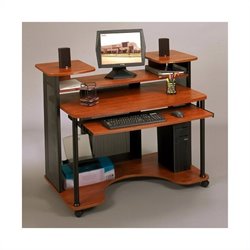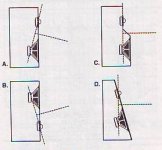I have seen a few speakers intentionally designed with the tweeter placed below the mid/woofer. A while back I took small speakers I used to use for near field, and placed tweeters on the bottom. Originally I wanted to get the port breeze out of my face. Then I noticed what seemed to be a more cohesive sounding reproduction. The speaker was designed to have the tweeter on top.
Why is that?
Why is that?
have a look at this series of directionality plots from John's site, and imagine them flippped upside down:
Power
That book is for those so technically inclined that they who can understand it would not need to ask my question for an answer! ;-) I am a novice.
From the book:
If you have a moment? Could you please simplify and explain in plain terms what the differences would be between symmetrical and asymmetric polar responses? How would the patterns differ with type of each crossover?...how significant is it if the vertical polar response is symmetrical, as with a Linkwitz/Riley crossover, or asymmetric as with a Butterworth crossover?
Now after all I read? I found nothing to explain what might be gained with having the tweeter located below the woofer. That was my question.
Usually inverted driver arrangement is used with using odd order filters to compensate for the downward polar tilt caused by phase differences between the HP and LP. Reverse the drivers and if they are placed to give the right upward tilt can give a 0° ZDP (zero delay plane).
There's a good section on this in the Loudspeaker Design Cookbook (6th ed, section 7.23).
There's a good section on this in the Loudspeaker Design Cookbook (6th ed, section 7.23).
I wonder if you're listening near field, are they sitting on a desk or something? Maybe with the tweeter on the bottom you're reflecting off the desk.
My speakers are on two small platform shelves to the right and left. I have the speakers sitting to the very front edge as to avoid reflections as much as possible.

My speakers are on two small platform shelves to the right and left. I have the speakers sitting to the very front edge as to avoid reflections as much as possible.

You may still be closer to a reflecting surface that way, or depending on your ear height relative to the tweeter could have changed if you're in near field also.
Flipping a pair of loudspeakers around will completely change the phase relationship between the two drive units and your ear and depending on the design could result in a significant change between the frequency response of each arrangement. It is not surprising that they sound different. As to which way is best will only really depend on one thing - which way you think sounds best.
GeneZ, have another look at those graphs. What they are showing you is how the sound radiates into the room, looking at the speaker from the side. If flipping the speaker makes a difference, you have odd-order crossovers, and the directionality change, combined with your listening position, works better for you.
You may still be closer to a reflecting surface that way, or depending on your ear height relative to the tweeter could have changed if you're in near field also.
Those were not my speakers you see. That was an online picture of the desk.
Mine are these:

My speakers are sitting all the way up to the very front edge of those small shelves. The tweeters are at ear level . If I had my druthers, I would have a more standard type table and use small stands to lift the speakers up to ear level without having any shelving underneath. Right now I am using acoustic foam and two small pillows to dampen reflections and to fill in cavitations.
Even if placed on the edge of that shelf, if it's like the desk in the photo, you have the main surface below that which is closer to the tweeter (now) than it was before.
I have given up on the idea of turning them upside down. It was the interaction between the mid/woofer with my desk I was more concerned about. The further the mid/woofer from the desk surface would also have its benefits. That's why free standing stands are good for avoiding certain aberrations with the imaging.
Are you using metal cones to 'hold' the speakers ,or directly ,or felt ?!
Can the kind of acoustic loading of the tweeter ( waveguide ,horn ) be responsable of the difference whem turned upside down ( less dependance from position ) ?
I sheet of semi-soft perforated rubberized matting is what the speakers rest on. The speakers also come with a rubber matting on their bottom.
I once read that placing the speaker upside down can help with the comb effect. But, what that effect is was not defined. I thought maybe I would learn something about it here.
Last edited:
I once read that placing the speaker upside down can help with the comb effect.
The first time that I 've read ,published on hifi mag ,about driver offset ,it was clearly understandable that the line perpendicular to the ...
OK it's too much for me !!
Indeed , it may be easier to understand the basic concepts and go further in knowledge ,than keeping the simplified way that is made to explain some complex things to the beginner ,,,
Your little speakers have this bonus to try to put driver's centers on axis , so
crossover's duty is simplified ....I'm oversimplifying ???
So speakers directivity is also less-dependable upon cabinet orientation ...I'm making my own guessing . Probably the tweeter may have took advantages with near reflections and what you heard was a 'bright expanded' sound .
Your little speakers have this bonus to try to put driver's centers on axis , so
crossover's duty is simplified ....I'm oversimplifying ???
My concept of a realistic ideal would be able to have a means to control the tilt of the boxes backwards in controlled increments.
So speakers directivity is also less-dependable upon cabinet orientation ...I'm making my own guessing . Probably the tweeter may have took advantages with near reflections and what you heard was a 'bright expanded' sound .
I do not hear a bright sound. Did I mention I did? I am simply trying to find ways to optimize what I have.
Indeed ,it was an imaginary line joining driver centers ,from which perpendicularly , you see different irradiation angles .it was clearly understandable that the line perpendicular to the ...
OK it's too much for me !!
as you say ,
That not happens ,when you are in the 'sweet spot' , only with just a different offset of the drivers , or ..it not may be reached as easily as it seems .... a realistic ideal would be able to have a means to control the tilt of the boxes backwards in controlled increments.
Thou the job of the crossover is to correct emissions also through a
correct off-axis decay .
- Status
- This old topic is closed. If you want to reopen this topic, contact a moderator using the "Report Post" button.
- Home
- Loudspeakers
- Multi-Way
- Tweeter side down. Woofer on top.
